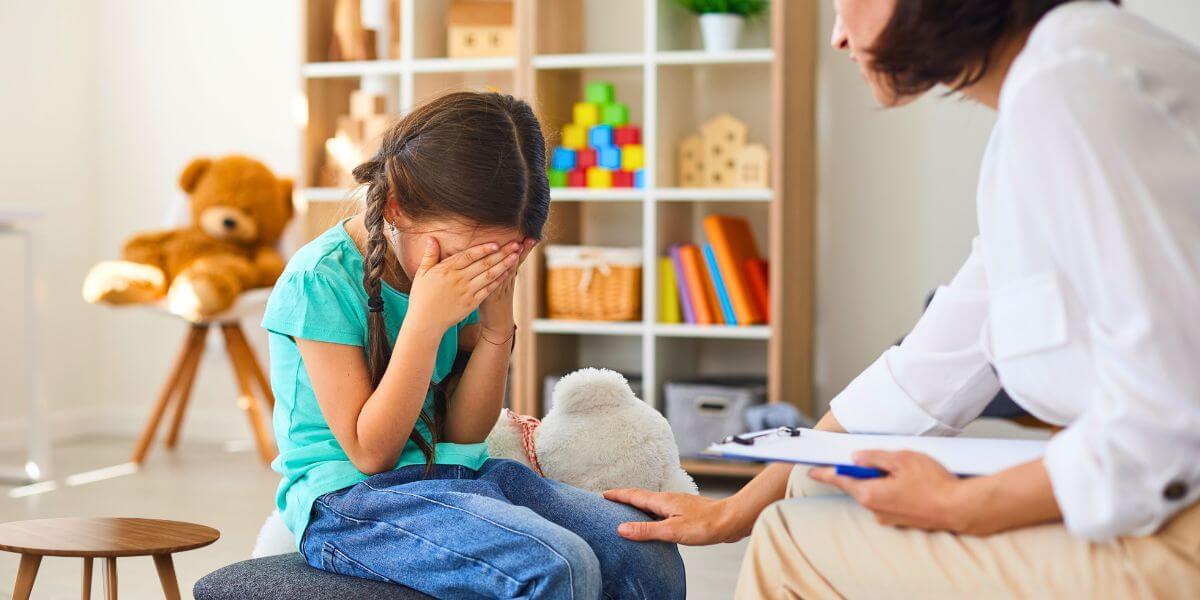Being a parent is one of the hardest jobs, filled with both rewarding and tough moments. Sometimes, kids can say or do something that hurts deeply, making mom or dad feel mad, sad, or even alone. It’s important for parents to know that it’s normal for these things to happen as children grow and learn to handle big emotions.
If you’re wondering what to do when your child hurts you emotionally, start by recognizing that their words or actions don’t always reflect their true feelings. This can be an opportunity to teach them how to express feelings and regulate their emotions, showing that while it’s okay to feel upset, there are better ways to communicate.
All parents need to remember that these moments do not break trust but help kids become more understanding people who can have a happy, fulfilled life.

Recognizing Different Types of Guilt
Guilt is a common feeling that many parents experience when their children react negatively, but it’s important to understand the different types. The first type of guilt comes from when we act against our own values or fail to meet our own internal expectations. The second type involves feeling bad because we have displeased or let down someone else, which can lead to discomfort or disappointment.
For example, if a boundary you set displeases your child, you may feel guilty for causing their upset, even when it’s necessary. This latter type of guilt often gets transmuted into worry or stress because we don’t want to see loved ones hurt.
Recognizing which type you are feeling helps you find the right answer and stay true to your values while balancing your child’s needs.
Understanding the Reality of Emotions
Feelings can be powerful and sometimes make parents feel like a victim in the moment. But the truth is that these emotions are informative and can be used as an invitation to learn and grow.
“You Can’t Hurt My Feelings and I Can’t Hurt Yours”
When a child’s words provoke an emotional reaction, it’s easy to feel like they can cause you pain. However, recognizing that we are in charge of our own internal responses is crucial. Triggers from others are often an invitation to reflect on why we feel hurt and to learn and grow from the experience.
Although people can say things that touch a nerve, the meaning we ascribe to these moments is shaped by our self and our emotional history. By staying present and focusing on the current situation, we remind ourselves that feelings are not solely caused by external events. Instead, they are influenced by our internal perspective.
This mindset helps us remain grounded and maintain intimate connections with our children while understanding the true source of emotional responses.
Accepting That Everyone Can Have Their Own Feelings
Adults and children are both allowed to have their own feelings, even if they are different. When emotions are running high, it’s easy for things to escalate, especially if there is emotional dysregulation on either side. Recognizing this helps create a boundary where each person’s feelings are respected without trying to override them.
Not every reaction has to fit into a specific ideology of what is “right.” Emotions exist on a spectrum, and learning to control our responses helps prevent unnecessary conflict. This approach helps everyone feel heard and valued, maintaining a calm and understanding environment.
Understanding the Difference Between Empathy and Codependency
Empathy means understanding and feeling what others are going through, while codependency happens when we lose ourselves trying to meet someone else’s needs. It’s important to differentiate between the two and set boundaries that help maintain healthy relationships.
Empathizing with your child by putting yourself in their shoes can guide you in responding with care, but it shouldn’t lead to an enmesh of emotions where you modify your own behavior to protect their feelings constantly.
Remember that meeting their desires should not come at the expense of your own well-being. The bottom line is to show love and understanding while keeping clear boundaries that protect both parent and child.
Understanding Why It Happens
Emotional Growth of Children
Children are still learning how to manage and express their emotions as they grow. Their emotional development is a long process, and when they are young, their brain is still developing the parts that control their reactions. This is why they sometimes feel strong emotions like frustration, sadness, or anger, which can lead to hurtful words or outbursts.
Parents may hear these things during moments when their child is overwhelmed or upset, but often, the child isn’t fully aware of the meaning behind what they say. When a parent hears shouting or sees an angry outburst, it’s usually not about them doing something wrong but rather a sign that their child is trying to navigate these big emotions and sometimes failing to do so calmly.
Being patient and recognizing these behaviors as part of their growth helps parents stay calm and supportive during tough times.
External Influences Affect Children’s Behavior
A child’s behavior can be shaped by many external influences. Experiences at school, like a mean comment from a classmate or a hard test, can lead to stress that they bring home. Peer pressure and friends can also impact how children act and behave, as they may copy what they see others doing, even if it’s hurtful. Sibling rivalry is another common source of tension—brothers and sisters fighting for attention or space can create arguments over toys and other small things.
Understanding that these situations might be why your child acts out helps you see that their behavior is not always about you but is influenced by what they face earlier in the day. This perspective can make it easier to handle harsh words or actions with patience.
Why Children Seek Independence and How It Affects Their Behavior

As children grow older, they naturally want to be more independent and make their own choices. This can sometimes lead to defiance, where they argue or refuse to do what they are told by parents. It’s important to know that this is a normal part of growing up and doesn’t always mean they don’t care. Figuring out their own voice and learning to be in charge of themselves can make them act out or test rules.
Understanding that this behavior is part of their emotional growth helps you to guide them with kindness and patience. Parents play a key role during these hard times, teaching them how to handle their desire for freedom in a loving way. While it can be challenging, this phase is essential for them to learn about themselves and become confident adults.
Blurred Boundaries in Family Dynamics
When boundaries in a family become unclear, it can have a strong impact on emotional responses. Children need real boundaries to feel secure, but when the line blurs between parent and child roles, patterns of confusion and emotional strain grow.
Struggle arises when attachments feel too close, and space to express individual feelings becomes limited. Living without a clear distinction of where support begins and ends makes it hard to maintain balance in the family system.
Parents may find themselves asked to give more than they can, as the boundary becomes too narrow, leading to emotional exhaustion. We need to set healthy limits to ensure mutual respect and lessen the pressure that blurred roles create, so everyone can grow in a safe, supported way.
Identifying Your Own Emotional Triggers
Sometimes, moments from your past or experiences while growing up can still affect how you feel today. For instance, if a parent often criticized you, this can make you more sensitive to negative feedback even now. When someone says or does something that touches a nerve, it can bring back old feelings, making you react more strongly than you might otherwise.
It’s important to take time to pause and listen to yourself, especially when life is busy, so you can start recognizing your vulnerabilities. Understand why certain actions make you feel guilty or hurt—these feelings often repeat when similar situations happen. Think of times when you felt criticized or remind yourself of instances when you were sensitive as a child.
Doing this helps you be more prepared for when these emotional reactions occur, allowing you to understand and work through them together with others. Separate Past Experiences from Present Situations
Understanding the Struggles of Adulthood Rooted in Childhood
The struggle of adulthood often feels hard because it is rooted in past experiences. Our minds and bodies store emotional information from when we were children, which can keep us in a cycle of questioning and wondering why certain things feel wrong or difficult.
While we may try to think logically and find answers, it doesn’t always help because these feelings are not just about what’s happening now—they’re about what keeps coming up from before. We might feel a deep need to be perfect or safe, making it tough to accept when things go wrong or when we can’t give as much as we want.
This leads to wondering what’s wrong and why we struggle so much, even though we do our best to care and stay strong. Understanding this helps us feel more compassionate toward ourselves and recognize the deep roots of our reactions.
Understanding How Childhood Shapes Emotional Reactions
Emotional responses can often be caused by beliefs and adaptations acquired in childhood. Many of us, as parents, may find ourselves reacting in certain ways because of past experiences, like being punished or told our emotions were too big.
Recall if there were times when yourself as a child had needs that weren’t met, or when making a mistake led to feelings of fear. It is important to invite these memories back to recognize how they shape your reactions today.
Remember that seeing situations through the eyes of your child helps to understand their true wants and needs, allowing you to respond thoughtfully without falling into old, limiting habits.
Recognizing Internalized Beliefs from Childhood
Internalized limiting beliefs often come from moments in childhood when we felt criticized or misunderstood. These beliefs can shape how we react when hurt, making one feel defensive or unsure of how to respond calmly. Following such patterns, more negative reactions may appear when our children say something upsetting.
Understanding that these beliefs have become part of how we think helps in breaking the cycle. By recognizing one of these moments, we can learn to respond with empathy and care, instead of repeating the same reactions learned in childhood.
The Power of the Brain to Adapt

The brain is an amazing and changeable organ, which means it’s capable of learning and adapting at any age. By the time a child reaches age three, 90% of their brain’s circuits are already developed, and by age five, it’s around 75% connected. But the cool thing is that the brain remains plastic throughout life.
Our ability to create new connections doesn’t end in childhood; it is something we continue to have as adults. This means that even if we feel wired in certain ways due to past experiences, we are still capable of creating new responses and thought patterns.
While our initial responses may be strong and automatic, recognizing this ability can help us approach emotional challenges with more hope and patience.
Tools for Managing Emotional Reactions
Here I will share with you some tips to understand emotional reactions and feelings which will surely help you.
- Understanding Common Emotional Expressions from Your Child
- Managing Your Immediate Reaction
- Communicating Openly with Your Child
- Strengthening the Parent-Child Bond
- Create Supportive Mantras for Parenting
- Teaching Kids About Emotions Through Play
1. Understanding Common Emotional Expressions from Your Child
When your children say things like “You hurt my feelings!” or “You make me so mad!,” these words can be tough to hear but are common and often come up many times. These messages may feel familiar because most of us have heard or even spoken them before. Kids are wired to express their emotions directly, especially when they feel upset.
It’s important to remember that they are not always trying to cause pain but are simply using the most immediate way to say what’s on their mind.
These expressions are given in moments when emotions run high, and their upbringing influences how they start sharing their feelings. This helps remind us to approach these moments with understanding and patience.
2. Managing Your Immediate Reaction
Pause and Think Before Responding
When your child says something hurtful, it can be very hard for parents to keep their emotions in check. Feeling anger or sadness is natural, but taking a moment to pause can make a big difference. Before you react, take a deep breath, and think about how to best respond.
This gives you a chance to gather your thoughts and maintain control. Counting to ten or taking a brief break can prevent actions or words you might regret later. Teaching yourself to stay calm and thoughtful not only helps you but also sets a strong lesson for your kids, showing them how to manage their emotions in their own lives.
Avoid Reacting with Anger
When faced with a tough situation where your child’s words or actions upset you, it’s easy to fall into reacting with anger. Yelling or using a harsh tone might feel like a release, but it can make the problem worse by escalating the argument. Shouting can scare your child and make them more upset, which does not solve the issue. Instead, take a moment to stay calm and in control of your feelings.
It’s normal to feel emotional, but staying cool and choosing to respond thoughtfully helps you handle the situation better. Sometimes, taking a break or stepping away when emotions are high can prevent the issue from turning into a bigger problem.
This approach teaches your child that even in difficult moments, staying composed is important. Ignoring the impulse to react harshly gives you a chance to solve the situation without anyone running from it emotionally.
Taking Responsibility for Your Emotions
As humans, we all have emotions that can feel like energy in motion, especially when hurt. It’s important to own these feelings and give yourself permission to process them without judgment. When you feel frustrated or overwhelmed, don’t try to pretend everything is fine or let your emotions explode.
Instead, use “I statements” to express what you’re experiencing, like, “I feel sad when that happens.” This helps kids see that it’s okay to feel and talk about emotions. Acknowledge your distress and regulate your response to model healthy behavior.
Whether playing with toys or working through hitting or other actions together, show your child how to process emotions without making them feel unsafe or insecure. This approach demonstrates that everyone has feelings and can learn to handle them respectfully.
Connecting with Your Inner Child
When your child’s words trigger a strong emotional response, it’s helpful to revisit your inner child. This can mean recognizing feelings of guilt or being scared of making a mistake that stem from past experiences. Remember, you are not responsible for always being perfect or falling into people-pleasing patterns to feel good enough.
Show compassion to yourself and acknowledge that your current reactions may come from old attachment wounds. By addressing these feelings, you can rewire your brain to respond more calmly and keep an authentic connection with your child. This approach helps you stay balanced and truly happy without letting old fears shrink your confidence.
3. Communicating Openly with Your Child
Choosing the Right Time to Talk
When your child does something that upsets you, finding the right time to talk is very important. As a parent, you need to think carefully about when to have a serious conversation. Timing matters because talking when either of you is angry or too upset will not go smoothly.
Wait until both of you are calm and can listen clearly. A rushed or distracted moment, like during dinner or before bed, is not ideal. Instead, choose a quiet and relaxed time, maybe in the afternoon or during a walk, when both of you feel more comfortable. This makes the talk go better and helps everyone feel heard.
Listening to Their Perspective
It’s important for parents to give their child a chance to share their thoughts and feel that their words matter. When they feel frustrated or mad, they need to know they are understood. Listening without interrupting and nodding shows you care about what they are telling you. This makes them feel safe and more likely to talk openly.
When you respond, do it in a way that shows you want to solve problems together as a family. Being good listeners and not just talkers builds trust and shows that your home is full of caring and loved members. This makes everyone feel like a team, creating a better environment for open conversations.
4. Strengthening the Parent-Child Bond
Prioritizing Quality Time
Spending quality time with your child is very important for parents to build a strong and positive connection. Simple activities like playing a board game, cooking dinner together, or taking a walk in the park create special moments that make them feel loved and safe.
During these times, avoid distractions like work or phones and focus on them fully. This sends a clear message that they matter to you. These moments help you listen to their thoughts and feelings, learn about their day, and laugh together, strengthening bonds and making memories that last a lifetime. Such time spent helps your child feel connected and less worried about seeking attention elsewhere.
Building Trust Through Vulnerability
Being honest and open about your emotions when your child has hurt you can be tough, but it helps build trust. Sharing your true feelings, like admitting when you feel sad, tired, or down, shows them that everyone, even parents, experiences hard moments.
Letting them see you as a human who sometimes feels embarrassed or upset makes your connection closer. When you express that you’re disappointed without judged tones or fear of losing control, they learn empathy and understand that their actions affect others.
This openness creates a safe space, helping them become kinder and more understanding of the world around them and reinforcing that home is a place where feelings can be shared without fear.
Positive Reinforcement
Using positive reinforcement is a powerful way to encourage good behavior in your child. When you notice them being kind or respectful, praise them to show that their actions are valued. Simple words like, “I’m so proud of how you treated your friend today,” or, “I noticed you helped your sister—that was really kind,” can make a big impact.
Small rewards like a high-five, a hug, or extra playtime show your appreciation and keep them motivated to repeat these good habits. These moments make them feel happy and understood, reinforcing their positive choices and helping them develop lifelong respect and caring.
5. Create Supportive Mantras for Parenting
In parenting, creating new mantras can help manage tough emotions and guide your thoughts. When feeling pain or blame after a hurtful moment, remind yourself of phrases like, “I am doing my best, and that is enough,” or “My needs matter, too.”
These simple words can shift your mindset and give you the power to respond calmly. Mantras help set healthy boundaries by reinforcing that your actions and feelings are valid, without falling into shame. Teaching yourself these positive phrases helps to co-regulate with your child and show that it’s okay to handle emotions with care.
This approach shows that true strength in parenting comes from balancing wants and needs while modeling healthy coping mechanisms.
6. Teaching Kids About Emotions Through Play
Kids can learn a lot about emotions through fun activities. Using tools like the Time-In ToolKit®, which was created for child-development and social-emotional skill-building, helps them understand their feelings in a gentle way. Time-Ins, instead of Time-Outs, give children a chance to calm down and reflect.
This approach includes playful games and activities designed to make big emotions easier to navigate. Taking time with your little ones to practice Calming exercises helps them create good emotional habits.
Experts say starting with this kind of ToolKit® can teach everything they need to handle emotions from 2-9+ years old and beyond, turning any stressful moment into a learning Corner for growth.
Final Thoughts with Examples of how to respond to “I hate you”
Everything has already been explained in great detail above, but I think that the human mind can better understand with examples, so here are some examples according to different ages so that you can better understand.
Toddlers
When toddlers say, “I hate you,” it’s often because they are feeling big emotions and don’t fully understand how to deal with them. They may be angry, and their anger can come out in strong words. Instead of reacting negatively, tell them, “I know you’re feeling really angry right now, and that’s okay.”
By saying this, you show them that it’s normal to feel upset and help them feel safe enough to express themselves without fear. This way, they learn that even when their emotions are strong, they are still loved and supported.
Adolescents
When adolescents say “I hate you,” it can come from feeling overwhelmed or misunderstood. Their strong emotions make it hard for them to speak clearly and express what’s really going on inside. Stay calm and imagine what it feels like at the bottom of their frustration. Respond with understanding by saying, “I’m sorry you’re feeling this way.”
This helps them see you’re there to listen and support them, even when things are tough. Showing patience allows them to feel safe enough to open up when they’re ready.
Teens
When teens say “I hate you,” it’s often a sign that they are struggling with deep emotions. In these moments, make eye contact to show that you’re really listening and not just brushing them off. Your job is to stay composed and provide a safe space for them to express their feelings.
Even if you don’t agree with what they’re saying, reassure them that you care and are willing to take the time to understand. This approach helps them know they are valued and that your support remains, even during hard times.
